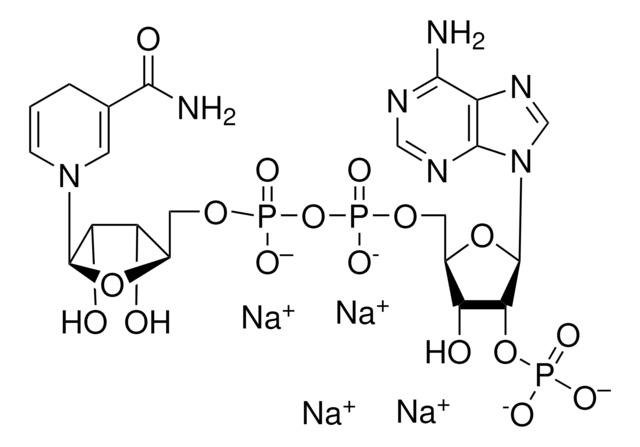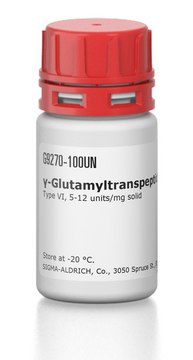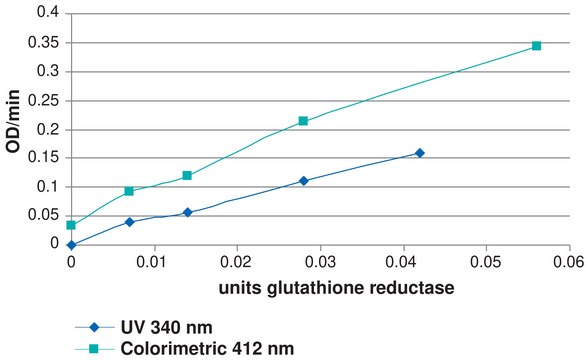G9297
Glutathione Reductase human
buffered aqueous solution, ≥10 units/mg protein, recombinant, expressed in E. coli
Synonyme(s) :
GR, Glutathione-disulfide reductase, NADPH:oxidized glutathione oxidoreductase
Se connecterpour consulter vos tarifs contractuels et ceux de votre entreprise/organisme
About This Item
CAS Number:
Numéro MDL:
Code UNSPSC :
12352203
Nomenclature NACRES :
NA.41
Produits recommandés
Description générale
Research area: Cell signaling. Glutathione Reductase belongs to the homodimericFAD−disulfide oxidoreductases family. is made up of highly conserved domains such as two Rossmann fold domains, where one binds to reduced nicotinamide adenine dinucleotide phosphate (NADPH) and flavin adenine dinucleotide (FAD) the second one is an interface dimerization domain. It favors its accumulation in the regions of high electron flux in cells where reactive species are generated.
Application
Human glutathione reductase has been used in:
- glutathione reductase activity assay
- oxidative stress analysis
- redox assays
Actions biochimiques/physiologiques
Glutathione reductase enzyme is a homodimeric enzyme containing 1 FAD molecule and 1 NADPH binding domain per subunit. Both human GR (hGR) and Plasmodium falciparum GR (PfGR) are essential for the survival of the malaria parasite within the human erythrocyte. Thus, this enzyme may be used for studies of candidate anti-malaria reagents.
Glutathione reductase is a ubiquitous flavoenzyme involved in the protection from cell stress. Glutathione reductase catalyzes the reduction of oxidized glutathione (GSSG) to glutathione (GSH). It is essential for the glutathione redox cycle that maintains adequate levels of reduced cellular GSH, which serves as an antioxidant reacting with free radicals and organic peroxides. Glutathione is also an electron donor for glutathione peroxidases and a substrate for glutathione S-transferases contributing to the detoxification and elimination of toxic electrophilic metabolites and xenobiotics.
Human glutathione reductase is suitable as cytostatic and antimalarialagent. It may also be used to protect against malaria by mimicking favism by blockingthe enzyme with specific inhibitors.
Définition de l'unité
1 unit will reduce 1.0 μmole of DTNB to TNB per minute at 25 °C at pH 7.5.
Forme physique
Solution containing 25 mM Tris-HCl, pH 7.4, 1 mM EDTA, and 50% (v/v) glycerol.
Clause de non-responsabilité
Unless otherwise stated in our catalog or other company documentation accompanying the product(s), our products are intended for research use only and are not to be used for any other purpose, which includes but is not limited to, unauthorized commercial uses, in vitro diagnostic uses, ex vivo or in vivo therapeutic uses or any type of consumption or application to humans or animals.
Produit(s) apparenté(s)
Code de la classe de stockage
10 - Combustible liquids
Classe de danger pour l'eau (WGK)
WGK 2
Point d'éclair (°F)
Not applicable
Point d'éclair (°C)
Not applicable
Équipement de protection individuelle
Eyeshields, Gloves, multi-purpose combination respirator cartridge (US)
Faites votre choix parmi les versions les plus récentes :
Déjà en possession de ce produit ?
Retrouvez la documentation relative aux produits que vous avez récemment achetés dans la Bibliothèque de documents.
Les clients ont également consulté
Notre équipe de scientifiques dispose d'une expérience dans tous les secteurs de la recherche, notamment en sciences de la vie, science des matériaux, synthèse chimique, chromatographie, analyse et dans de nombreux autres domaines..
Contacter notre Service technique






